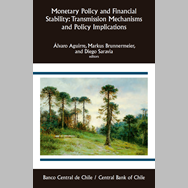Volumen 26, Serie Banca Central: Monetary Policy and Financial Stability: Transmission Mechanisms and Policy Implications
Publicaciones
Volumen 26: Monetary Policy and Financial Stability: Transmission Mechanisms and Policy Implications
Descripción
The global financial crisis that broke out 10 years ago uncovered the buildup of risks during a period of price and output stability. It challenged the previous consensus that preserving price stability was the optimal way to ensure financial stability, and led to a surge of interest in the multiple interactions between monetary policy frameworks, financial vulnerabilities and financial stability. This volume contributes to the study of these issues as well as the convenience of incorporating financial stability considerations in monetary policy frameworks, bringing together a multinational group of distinguished scholars to discuss the latest research findings. It is of utmost importance to understand how monetary policy affects both financial conditions and financial vulnerabilities that amplify negative shocks, as well as the potential intertemporal policy trade-off between improving current conditions and exacerbating future financial vulnerabilities.
Editors
Álvaro Aguirre
Markus Brunnermeier
Diego Saravia
Monetary Policy and Financial Stability, edited by Álvaro Aguirre, Markus Brunnermeier, and Diego Saravia, provides crystal-clear insights and creative solutions to the most crucial monetary problems facing the world today. Like no other book, it explores the benefits of new proposals, including a novel global safe asset and an optimal management of both reserves and capital flows, and it points out the costs of negative interest rates policies that create unsafe leverage ratios, of a long-term interest rate policies that lead to inflation instability, of macro-prudential policies that interfere with equity flows, and of leaning against the wind policies that cause serious macro instability.
John Taylor
Mary and Robert Raymond Professor of Economics at Stanford University and the George P. Shultz Senior Fellow in Economics at the Hoover Institution
The Global Financial Crisis highlighted the limitations of stand-alone monetary and regulatory policies in containing and responding to financial crises. Since then, academics and policymakers have searched for a deeper understanding of these two key policy tools and their interactions. This important book takes stock of some of the main lessons of the last decade and begins to formulate substantive policy proposals. A must read for academics and policymakers alike.
Ricardo Caballero
Ford International Professor of Economic and director of the World Economic Laboratory at the Massachusetts Institute of Technology
This volume addresses a crucial set of issues for central banks in the wake of the financial crisis: whether they should take responsibility for a broader set of objectives, including the avoidance of financial imbalances, and to what extent this requires them to expand the set of instruments that they use and the types of interventions that they undertake. It assembles contributions by leading international scholars on many different aspects of this complex of questions, and representing several alternative viewpoints. The book should be of great interest to academics, policymakers and financial analysts seeking a deeper understanding of this vital debate.
Michael Woodford
John Bates Clark Professor of Political Economy at Columbia University
The debate about the interaction of monetary policy and financial stability acquired renewed strength with the economic disruption generated by the great recession, the unconventional monetary-policy response that followed, and the central role acquired by asset markets in the transmission of shocks. This first rate volume edited by Alvaro Aguirre, Markus Brunnermeier and Diego Saravia represents a significant step towards the understanding of these issues and is a must read for scholars and policymakers.
Pablo Guidotti
Professor at the School of Government, Universidad Torcuato di Tella
Volumen 26: Monetary Policy and Financial Stability: Transmission Mechanisms and Policy Implications
Recuadros y gráficos

